
The Nightcap National Park is a national park situated within the Nightcap Range in the Northern Rivers region of New South Wales, Australia. The 8,080-hectare (20,000-acre) park was created in April 1983 and is situated 35 kilometres (22 mi) north of Lismore. The park was established following campaigns and blockades against logging at Terania Creek, Grier's Scrub and Mount Nardi between 1979 and 1982. Sections of the Whian Whian state forest were added to it following blockading and campaigning in 1998. The national park is classed by the IUCN World Commission on Protected Areas as Category II and is part of the Shield Volcano Group of the World Heritage Site Gondwana Rainforests of Australia inscribed in 1986 and added to the Australian National Heritage List in 2007.
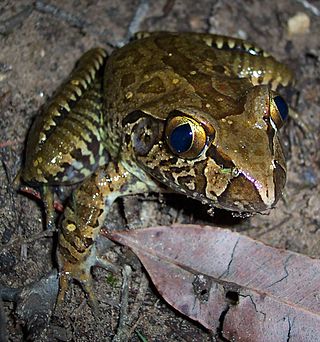
Conondale National Park is 130 km north of Brisbane in the Sunshine Coast Hinterland near the town of Conondale in the south east Queensland bioregion. The park covers an area of 35,648 hectares protecting large areas of subtropical rainforest, woodlands, wet and dry sclerophyll forest including Queensland's tallest tree. The park contains areas of regenerating forest which have been previously logged; areas of forest plantations also border the park. The park is currently managed by the Queensland Government under the Nature Conservation Act 1992.

Threatened fauna of Australia are those species and subspecies of birds, fish, frogs, insects, mammals, molluscs, crustaceans and reptiles to be found in Australia that are in danger of becoming extinct. This list is the list proclaimed under the Australian federal Environment Protection and Biodiversity Conservation Act 1999. The classifications are based on those used by the World Conservation Union (IUCN), however IUCN and Australian rankings do differ. Each state and territory has its own legislation relating to environmental protection.
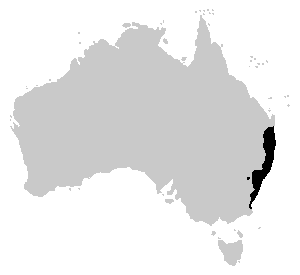
The robust bleating tree frog, also known as Keferstein's tree frog, is a species of tree frog in the subfamily Pelodryadinae. This frog is endemic to coastal eastern Australia, where it ranges from northeastern New South Wales to the NSW/Queensland border. It has also been introduced to Lord Howe Island.

The barred frogs are a group of frogs in the genus Mixophyes. They are the largest of the Australian ground frogs, from the family Myobatrachidae.

Rheobatrachus, whose members are known as the gastric-brooding frogs or platypus frogs, is a genus of extinct ground-dwelling frogs native to Queensland in eastern Australia. The genus consisted of only two species, both of which became extinct in the mid-1980s. The genus is unique because it contains the only two known frog species that incubated the prejuvenile stages of their offspring in the stomach of the mother.

The giant barred frog is a species of barred frog found in Australia. It occurs from south-eastern Queensland to just south of the Newcastle region in New South Wales. It is associated with flowing streams and creeks in wet sclerophyll and rainforest habitats from the coast to the ranges.

Fleay's barred frog is a large species of frog restricted to small pockets of rainforest in northern New South Wales and south-eastern Queensland, Australia.

The stuttering frog is a large species of frog that inhabits temperate and sub-tropical rainforest and wet sclerophyll forest in Australia.
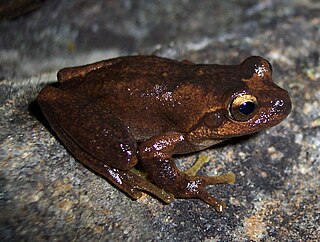
Littlejohn's tree frog, also called a heath frog or orange-bellied tree frog, is a species of tree frog native to eastern Australia from Wyong, New South Wales, to Buchan, Victoria.

Amphibians of Australia are limited to members of the order Anura, commonly known as frogs. All Australian frogs are in the suborder Neobatrachia, also known as the modern frogs, which make up the largest proportion of extant frog species. About 230 of the 5,280 species of frog are native to Australia with 93% of them endemic. Compared with other continents, species diversity is low, and may be related to the climate of most of the Australian continent. There are two known invasive amphibians, the cane toad and the smooth newt.
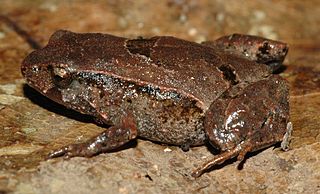
Assa is a genus of frog in the family Myobatrachidae. These frogs are endemic to a few parts of eastern Australia.
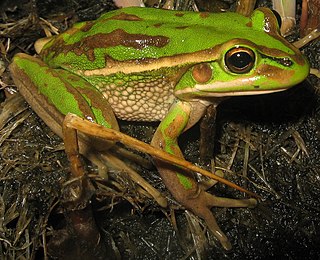
Ranoidea is a genus of frogs in the subfamily Pelodryadinae. They are found in Australia, New Guinea, and two nearby groups of islands: the Maluku Islands, and the Louisiade Archipelago. The circumscription of this taxon is still controversial.
Watson's tree frog, also known as the large brown tree frog or southern heath frog, is a species of tree frog endemic to south-eastern Australia.
The Central Ranges toadlet, or Everard Ranges toadlet, is a species of small frog that is endemic to Australia.

The screaming tree frog is a species of frog in the subfamily Pelodryadinae. It is endemic to southeastern Australia, east of the Great Dividing Range. It ranges from northeastern Victoria to the mid-coast of New South Wales, from Mallacoota north to Taree. This species is the "bleating tree frog" that occurs around Sydney, and is well known for its very loud call.
The slender bleating tree frog, is a frog in the family Hylidae. It is endemic to Australia, where it is found in Queensland and the Bunya Mountains. This is the "bleating tree frog" that occurs around Brisbane.
Assa wollumbin, the Wollumbin pouched frog or Mount Wollumbin hip-pocket frog, is a species of small, terrestrial frog endemic to New South Wales, Australia. It is restricted to the slopes of Mount Warning (Wollumbin), where it inhabits rainforest habitat.
The Mount Ballow mountain frog is a species of frog in the family Limnodynastidae. It is endemic to eastern Australia, straddling the border of Queensland and New South Wales. It is known only from the central and western McPherson Ranges, in the Gondwana Rainforests World Heritage Site.











